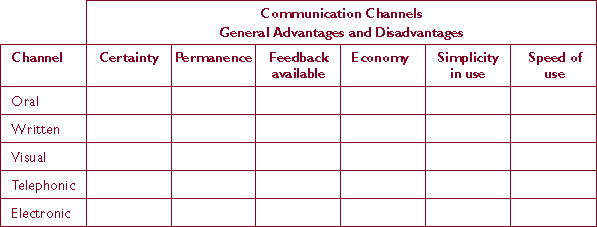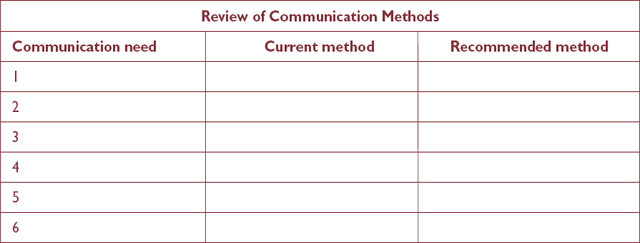Session B
Communication media
|
1 Introduction |
How many ways do you receive communications in a normal day? Face-to-face, no doubt, but also phone calls, text messages, faxes and emails? Television, radio, Internet, public address? There are more ways – or media – of communicating information available now than ever before.
This should be an advantage, but there are problems in it for senders and receivers. Too much information can be as much of a problem as too little.
|
Because no matter how sophisticated the delivery medium and how great its capacity to deliver 24/7, there are still only 168 hours in a week – and most people need to sleep for at least 25% of them. |
|
|
So, both at work and at home, people need to make informed choices about which medium to use and when to say ‘no’. |
|
|
The communication cycle (see Session A) applies to all media. Information is received, decoded, processed, encoded and transmitted. Some media, such as broadcasting, telephone networks and the Internet, effectively have infinite capacity to transmit data, but the people who do the processing – the makers of a feature film, for instance – do not. |
The GIGO principle – garbage in, garbage out – applies to every medium used, including email, text messaging and the intranets which many organizations use. The more information is fed into them, the more its quality and relevance needs to be controlled.
This session will help you to select the correct medium for the information you need to communicate – from face-to-face interviews to sending a message throughout the organization and beyond.
|
2 Choosing the right method of communication |
We are spoilt for choice when it comes to media. How do we choose the right medium for our message?
2.1 |
Looking at the medium’s effectiveness and efficiency |
‘Effectiveness’ and ‘efficiency’ are often used as though they mean more or less the same thing. But, in management terms, they have very different meanings.
Activity 14 |
|
What do you understand by these two ‘e’ words?
Efficiency
Effectiveness
I’m going to use the following definitions throughout this session; see how they compare with yours.
Efficiency is getting the greatest amount of output for the effort and resources being used.
Effectiveness is producing a desired result. It is a matter of quality as well as quantity. A desired result may not be quite the same thing as sheer amount of output, as the example below shows.
Activity 15 |
|
Holibus operates coach holidays throughout England and is planning a new advertising campaign. Most of their customers are in their 60s or above who don’t want to use their own cars. In all, Holibus wishes to take two hours of advertising on television, as a series of two-minute slots. They are offered rates for various times of day and night, and calculate that taking the off-peak slots at night could save them up to half the spend they had budgeted for.
What would you do in their position? Answer only one question ‘YES’.
1 Choose the peak-time rates to reach a wider audience | YES/NO |
2 Choose off-peak times to save money | YES/NO |
3 Neither of these | YES/NO |
If you choose option 3, what would you have done instead?
Let’s work out the arguments for and against each option.
Option 1
YES – This will use the money more efficiently, because we’ll reach many more people per £1 spent.
NO – It’s too expensive and many of the viewers won’t be our potential customers – that would be ineffective.
Option 2
YES – This will save us a lot of money. We could have twice as much advertising for the same price and that’s efficient.
NO – What’s the point of advertising when most of our potential customers are asleep? – that would not be effective.
Option 3
YES – We could use the money in other ways, like persuading existing customers to take a second holiday at a discount price. That could be more effective use of the money, because we know those customers already buy.
NO – Because we want to reach as many people as possible with advertising. That’s more efficient per £1 spent.
|
Probably, Option 3 would be the most effective use of the money, no matter how efficient TV advertising might be at reaching much larger numbers. If it didn’t persuade them to buy, then it wouldn’t matter how many of them had seen the ad. |
|
|
For all managers, the ideal world is one in which you combine effectiveness with efficiency, that is: |
|
|
you do the RIGHT thing in the BEST POSSIBLE way. |
Activity 16 |
|
You find out that 20 people out of 400 who work on a site may be greatly affected by a new pedestrian route from the main gate to their laboratory. Other employees may use the new path occasionally.
The message you have to send about the path is important, and safety issues are involved.
Because of cost and time, you have to keep this ideal in mind when you are choosing between, say:
1 putting a notice on the safety and welfare notice-board
2 sending an email to everyone on site
3 organizing a briefing for the people most affected by the topic.
What do you think would be the most efficient and the most effective ways of communicating about this path? Take into account the potential costs of each option as you see them, and use the grid to note the factors you believe should be considered. I’ve put in a ‘starter’ comment for each factor.
|
Option 1 |
Option 2 |
Option 3 |
Factors |
Notice on board |
Email to everyone |
Briefing for 20 people |
1 |
Most won’t read |
Many won’t read |
380 people not there but they may need to know |
2 |
|
|
|
3 |
|
|
|
4 |
|
|
|
5 |
|
|
|
6 |
|
|
|
My recommendation is:_________________________________________
Have a look at the other factors I came up with on page 61.
I hope you can see that there is more than one way to do the job. Sometimes a combination of methods may be needed to achieve effectiveness. In this case, for simplicity, you were offered only three options, though many others would have been available, such as a letter to all employees with their next salary advice.
How did your final recommendation agree with the following approach?
1 To brief the 20 people most affected in two groups of no more than 12.
2 To put a notice on the safety notice-board as a permanent reminder to all staff.
2.2 |
How to choose |
Your completed grid will show some of the factors which we need to take into account when choosing the most effective channel for communication.
Ask yourself these key questions.
|
|
Key question |
The answer affects the communication’s: | |
|
|
1 |
Do we need to communicate at all? |
Effectiveness |
|
|
2 |
Will we reach all the people who need to know? |
Effectiveness |
|
|
3 |
Can people deny having been told? |
effectiveness |
|
|
4 |
How long will it last? |
effectiveness |
|
5 |
Can we obtain feedback? |
effectiveness |
|
|
6 |
How much will it cost? |
efficiency |
|
|
7 |
How simple is it to use? |
efficiency |
|
|
8 |
How quickly can it be done? |
efficiency |
|
|
||||
|
Ideally, you are looking for a method of communication which: |
|||
|
||||
|
|
reaches everyone who needs to know |
=effective |
|
|
|
is acknowledged by them |
=effective |
|
|
|
has a reasonable shelf life |
=effective |
|
|
|
provides confirmation of understanding |
=effective |
|
|
|
|
is cheap, simple and quick to use |
=efficient |
|
|
The eight questions will help make a decision about any communication choice, from the very simplest – perhaps informing a team that a new colleague will be arriving next Monday – to the most complex, perhaps deciding how next year’s advertising budget should be spent. |
||
The first question – do we need to communicate at all? – is the most important of all. If the answer is ‘no’, then there is no point in going any further and spending anything (money or time) doing something which is unnecessary.
2.3 |
Who to choose |
Next we need to ask ourselves ‘Will we reach all the people who need to know?’
|
This is tricky. We might make the judgement that Mr X doesn’t need to know, and not communicate. If, in fact, he did need to know, we have failed in our objective of communicating effectively. |
|
|
But if indeed he didn’t need to know, then we have gone a small way towards saving the enormous sums that are spent each year on needless communications and the effects of information overload. This is especially true of emails, which take up so much of our time. |
|
|
As a manager, you have a duty to make the most effective use of all the resources which you have been given responsibility for, including communication resources. |
Next we need to make the big decision – which channel of communication to use.
2.4 |
What to choose from |
The choice open to us is huge, from long-standing systems to newer and more powerful electronic ones.
Activity 17 |
|
Think about what channels are available and what groups of people they are likely to be used for in your organization. Then, in the grid provided, list the various channels of communication used either directly by you or to you or by your organization as a whole.
Place a tick against each channel that is relevant for customers, employees, suppliers and the media.
|
Target Audience |
|||
Channels used |
Customers |
Employees |
Suppliers |
The media |
|
|
|
|
|
|
|
|
|
|
|
|
|
|
|
|
|
|
|
|
|
|
|
|
|
|
|
|
|
|
|
|
|
|
|
|
|
|
|
|
|
|
|
|
|
On page 62 you will find a grid completed with a large organization in mind, such as a supplier of products to multiple retailers with many sites around the country.
In fact, all or most of them are available to an organization of any size without excessive cost, though some of them may be unnecessary, and many are misused frequently.
Activity 18 |
|
I’ve grouped the various channels from Activity 17 into categories, for convenience.
Referring to the key questions 3–8 on page 30, and your own experience, how would you rate the strengths and weaknesses of each category, from Low to Medium to High? Complete the grid provided.

You will find a completed grid in the Answers to activities section on page 62.
2.5 |
The perfect communication solution |
Ideally, you would be looking for a channel which rated high in every category, one which was certain to get through, permanent, provided feedback to check understanding, and was economical, simple and quick to use.
In real life, there is no such perfect channel, so you will be looking for a workable compromise in all but the simplest situations.
The completed grid is not therefore a model which you can apply to any situation, nor does your version have to correspond to it to be right, for there is no right answer applicable to all situations.
But what you do need to do is choose the right communication channel objectively for a particular purpose, weighing the pros and cons of each before automatically picking up the phone, sending an email, calling a team briefing – whatever your instinctive preference may be.
Activity 19 |
|
Look at the following six practical situations and state what you believe would be the right solution to the communication problems they pose.
1 One of your delivery vehicles has had an accident and you need to advise customers that their deliveries will be affected.
2 You are working on a new quality manual and your boss wants to eliminate as much paper as possible.
3 You need to send a complicated draft mortgage offer to a client.
4 You need to bring your team up-to-date concerning three serious near misses which have happened recently.
5 You need to check if seven people from other sites and departments can attend a sales meeting in three days’ time.
6 Contractors’ employees have been using the staff restaurant and cloakrooms without authorization.
You will find a series of suggestions on page 63, with a short explanation of why they were chosen.
No doubt your own recommendations range widely, as mine do, across the available channels, to suit the needs of the situation you are in.
Though your answers may differ to some extent, what really matters is the decision-making process which you have gone through, based on the activities in this session, your own experience and the resources available to you.
|
3 Face-to-face communication |
There is one kind of communication which does come naturally to virtually everyone, almost like breathing, so why does anyone need to think about how they do it?
It is perhaps because people often don’t recognize the difference between:
![]() a friendly conversation – which does not have to achieve any particular objective; and
a friendly conversation – which does not have to achieve any particular objective; and
![]() a business communication, which does.
a business communication, which does.
|
Friendly conversations are essential to getting to know more about your team and building good relationships within it, but there are many occasions for which a more formal structure is required. You will earn respect from your team if they know that you will create a businesslike, purposeful atmosphere when the object of the communication is to get things done as a result of it. |
|
|
Many people – and you may be one of them – actually resent having their time wasted going down ‘blind alleys’, with irrelevant subjects or the constant repetition of things which they know about already. |
|
|
People also forget, or ignore, the basic principle of communication, which is that it is a cycle, with information flowing in more than one direction – or at least needing to flow in more than one direction. |
3.1 |
A structure for effective face-to-face communication |
The following approach has been tried and tested in many circumstances and over many generations.
Stage | Comments |
1 Decide what you want to achieve. | Is this a briefing meeting, a counselling session, a disciplinary hearing? The facts required will differ widely. |
2 Gather your materials. | These must relate directly to your objective. |
3 Arrange them into a logical flow – with a clear beginning, middle and end. Decide how you can persuade your listeners to do what you require willingly. | Think it through carefully from the listeners’ perspective – if they already know the content, why are you talking to them? |
4 Tailor the pitch of your language to suit your listeners. | This will be different as between, say, new recruits and experienced employees who know any jargon you may use as shorthand. |
5 Anticipate objections and counter-arguments which may arise. If you tell people why you need them to do something they are far more likely to co-operate. | Forewarned is forearmed – if you are dealing with a tricky subject, like poor performance, you need to think through the defensive reactions you may receive. |
6 Decide what advice and/or feedback you are looking for. | You don’t have to be the fount of all wisdom – teams should contribute to their own self-improvement, and communication is most effective when it works two ways. |
7 Plan a summary or conclusion which will leave your listener knowing what they need to know – and committed to whatever actions may be required. | On the basis of ‘if you go away knowing nothing else – be sure to remember this’. If you are looking for improved performance, your audience must want to do it for you. |
8 If possible, practise beforehand with a friendly listener. | Try not to go through your learning curve at the expense of your audience, whatever its size. |
3.2 |
Passive listening |
Now, let’s look at the other aspect of face-to-face communication: listening.
Did you know that human beings speak at around 125 words per minute, but can think at 600 words per minute or more?
That’s four times as fast – so there should be no problem. But frequently, there is.
Activity 20 |
|
Write down as many symptoms as you can think of for people who are bad listeners. Concentrate on matters which are within the listener’s control, so exclude:
![]() environmental factors. No one can listen to a briefing when standing next to a pneumatic drill – but they can try to ensure they get enough sleep and so don’t fall asleep;
environmental factors. No one can listen to a briefing when standing next to a pneumatic drill – but they can try to ensure they get enough sleep and so don’t fall asleep;
![]() faults which lie with the speaker – such as mumbling or rambling delivery.
faults which lie with the speaker – such as mumbling or rambling delivery.
Aim for about six reasons, based on your own experience.
|
||
|
||
|
||
|
||
|
||
|
I expect your list looks something like mine:
1 assuming the subject is boring beforehand – and so ‘switching off ’ before the unfortunate speaker has begun;
2 ignoring the content of what is being said and just attacking the way it is delivered in a nit picking fashion which gives no chance for a fair hearing;
3 frequent interrupting – which is really a sign of wishing to dominate the proceedings and ‘put down’ the speaker;
4 going to sleep – through lack of concentration or fatigue brought on by too little sleep;
5 closing the mind to technical or awkward topics;
6 day dreaming;
|
7 picking fights – latching onto a word like ‘poor’ (as in performance) or ‘unacceptable’ (as in standards) in the ‘what do you mean by that’ aggressive mode; |
|
|
8 listening selectively – usually to only what is of interest, like a specialist subject, or represents good news, like bonus payments. |
|
|
Do you recognize any of the symptoms in yourself? If you do, then you are in very good company – for while listening comes naturally to human beings and requires no effort, hearing requires positive effort. |
3.3 |
Active hearing |
If you can recognize the symptoms, you should be in with a good chance of finding a cure.
Activity 21 |
|
Think of some simple ways in which people showing the symptoms identified above can cure them – and so move from passive listening to active hearing.
Take each of the eight symptoms in turn. Begin each sentence ‘They should try to . . .’. I’ve completed Number 1, to get you started.
1 |
They should try to . . . have an open mind and let the speaker convince them that the topic is interesting. |
2 |
|
|
|
3 |
|
|
|
4 |
|
|
|
5 |
|
|
|
6 |
|
|
|
7 |
|
|
|
8 |
You will find some suggestions in the ‘Answers to activities’ section on page 63.
Of them all, the single most important for most poor listeners is simply to look at the speaker, cutting out any visual distractions.
|
4 Gathering and using feedback |
When you are the sender of the information, you need to know that you have been understood. This is especially important with verbal communication when the receiver has nothing to refer to when you have finished.
You do this by asking questions and being an active hearer of answers to the questions you have asked. Because if you don’t listen, it doesn’t really make any difference how polished your questioning techniques are.
But there are some other things you can do as well to get the feedback you need.
4.1 |
Observation |
In face-to-face communication you can see the person or people you are addressing. Just as they should focus on you to improve their active hearing, so should you observe their reactions to what you are saying.
Activity 22 |
|
Picture the following scenes and ask yourself what feedback the speaker is receiving, without anybody saying a word. Jot down your thoughts.
Marita was briefing her shop staff about changes to delivery arrangements beginning the following week. There were five women listening. One looked stony faced throughout; another shook her head every so often; the third looked down at her feet; the fourth, who was a new starter, was evidently concentrating hard; and the fifth occasionally clicked her teeth, or drew in her breath.
Your thoughts:
Sean was talking to the stablehands in the racing stable where he worked. He had just heard from the trainer that an important owner was going to place ten good horses with them next season. Six staff were present. One was smiling broadly; the second nodded frequently; the third – known to be work-shy – looked dubious; another made a ‘thumbs up’ signal; one – famously emotional about ‘his’ horses – was almost in tears; and the sixth, who had just married, opened a wallet and gestured as though putting money in it.
Your thoughts:
Did your thoughts run along the same lines as mine?
Marita was evidently giving unwelcome news, perhaps because her staff (other than the new recruit) simply don’t like change – or they fear the new arrangements will alter the service they give to customers. If Marita was looking around her team as she spoke, she would have picked up the signals of doubt and disagreement without anything being said.
Sean had very good news to impart – except to the work-shy lad. New, good horses are a boost for morale, and would only be placed with them because they are thought to be a good operation. Also, there is a chance of more prize money and improved job security. No wonder that most of the team looked so happy about it – something that Sean would see if he looked around them as he spoke.
These are examples of feedback coming from interpreting body language and non-verbal communication, which we will look at fully in Session C.
Note for now what an immediate and powerful way observation is of obtaining feedback from face-to-face communication.
4.2 |
Knowing your people |
In both the scenes pictured above it was implied that the managers knew their people as individuals – who was work-shy, who loved the job, who was a new starter, who needed more money.
This is important when interpreting their reactions because:
![]() some people can look miserable even when they are perfectly happy;
some people can look miserable even when they are perfectly happy;
![]() others try never to show emotion of any kind;
others try never to show emotion of any kind;
![]() others seem to look perpetually cheerful, whatever the situation.
others seem to look perpetually cheerful, whatever the situation.
If you don’t know them as people, you won’t be able to allow for these idiosyncrasies and may misinterpret what you see.
4.3 |
Asking questions |
You will get more precise feedback by asking questions, as Mick is trying to do here.
Activity 23 |
|
Mick has just given a ten-minute briefing on bank holiday working arrangements in the warehouse. He looks around the team and says:
‘Everyone OK about that, taken it all in all right?’
There were a few nods and grunts and Mick said:
‘Good, let’s all get back to work then.’
How much feedback do you think he has obtained from the question posed?
You probably answered ‘none’ or ‘very little’ – or words to that effect. The question he asked was a closed one – inviting a yes/no answer. In fact questions in that form – the ‘Everyone happy so far?’ kind – do not invite feedback of any sort, even an honest ‘no!’
Closed questions cut short discussion and are not helpful if you want to check people’s understanding, or reactions, either emotional or reasoned, to what you have said.
But they are useful for confirming what has been heard and for keeping control of the length of a discussion, as in:
‘Have we covered everything you needed to know about the new arrangements?’
Mick would have found out much more by asking open questions, for example as follows, where he has briefed the staff on working arrangements which are both complicated and unwelcome, at least to some staff.
![]() How do you think this will work out in practice for the drivers?
How do you think this will work out in practice for the drivers?
![]() What differences can you see from last year?
What differences can you see from last year?
![]() Which change do you think will cause most problems?
Which change do you think will cause most problems?
![]() Where do you reckon most of the drivers will be on the day before Christmas Eve?
Where do you reckon most of the drivers will be on the day before Christmas Eve?
![]() When do you want me to go through the final details?
When do you want me to go through the final details?
![]() Who is likely to make a fuss among the customers?
Who is likely to make a fuss among the customers?
![]() Why do you think we’ve had to make the changes this year?
Why do you think we’ve had to make the changes this year?
All these open questions invite people to talk and say what they think.
Mick may not always like what he hears, but at least he will find out what problems and misgivings there are. Then he will have the chance to do something about them in the immediate future.
4.4 |
Using feedback |
What do you do with feedback once you’ve got it? It depends.
![]() You may simply need to clarify something which the listener misheard.
You may simply need to clarify something which the listener misheard.
![]() You may need to make changes to the plan you were describing, because the feedback shows it needs improvement.
You may need to make changes to the plan you were describing, because the feedback shows it needs improvement.
![]() You may have to emphasize that the understanding is correct and that the plan will go ahead as described, despite the reservations people have. None of us gets everything we want all the time.
You may have to emphasize that the understanding is correct and that the plan will go ahead as described, despite the reservations people have. None of us gets everything we want all the time.
4.5 |
Telephone and other ‘remote’ verbal communication |
|
5 Non-verbal communication |
Let’s go back now to a subject that we saw briefly in Session A – communication which takes place without language, i.e. ‘body language’ or ‘non-verbal communication’. When should a manager pay attention to this?
The short answer is: always. We all register and interpret such behaviour all the time, it comes naturally. But acting on it is another matter.
5.1 |
Receiving non-verbal communication |
Sometimes a straightforward instruction must be issued. The only feedback required is to see evidence that the instruction has been carried out.
A very good example of this is an emergency situation, such as an evacuation for fire or an accident about to happen in a warehouse.
Say a person is about to drive a forklift into someone whom they cannot see from their cab.
![]() There is no time for a discussion.
There is no time for a discussion.
![]() The people involved should have been trained beforehand in the procedures.
The people involved should have been trained beforehand in the procedures.
![]() They must know what to do – obey the instruction – and trust the person giving the instruction.
They must know what to do – obey the instruction – and trust the person giving the instruction.
As a manager, you have to develop enough trust in your team members so that they know to react appropriately, that you are not just throwing your weight around. And a good tip is to use an ‘order’ tone only when circumstances justify it.
5.2 |
Giving information in non-verbal form |
We covered how you receive non-verbal communication in section 4.1 Observation. What about using it to give information to members of your team, or to other people affected by what they are doing?
Activity 24 |
|
Can you list four situations when it would be appropriate and necessary for you to use non-verbal means of sending a message to your team or a member of it? Think of a means of communication you could use employing the senses of touch, sight, smell and taste.
|
|
Touch |
|
|
|
||
|
Sight |
||
|
|||
|
Smell |
||
|
|||
|
Taste | ||
|
|||
I found it harder to find examples of using smell and taste, but these are the ones I came up with.
Touch – Taking someone’s arm to prevent their walking into some danger where there was no time to shout a warning. If you have team members with poor vision, you may need to use such tactile signals for various purposes, especially where safety is concerned.
Sight – Hand signals are used in many situations where noise or distance make a verbal communication inaudible, or too slow to interpret. Signals are used for directing vehicles, showing how a heavy load is to be manoeuvred safely, showing approval or the reverse with the well known ‘thumbs up’ or ‘thumbs down’ signals. Colours are introduced sometimes as warnings. For example, food not fit for human consumption is often marked blue – a rare colour to find in human food.
Smell – A distinctive smell was introduced into odourless gas supplies to warn householders and gas fitters of the presence of gas – a safer way of finding out than by lighting a match.
Taste – A poisonous but innocuous-tasting substance could be given a nasty flavour to deter consumption (by animals as well as people).
5.3 |
Interpreting the signals |
For communication to be effective, both the sender and receiver need to interpret them in the same way. For example, crane drivers use a simple code which everyone working on a dock is trained to use, leaving no room for misunderstanding.
Otherwise, you are in the same position as two speakers, one of them using
Japanese and the other responding in Gaelic. For example:
![]() though a shake of the head means ‘no’ and a nod means ‘yes’ to most western Europeans, you just may be observing people for whom the signals are reversed or meaningless;
though a shake of the head means ‘no’ and a nod means ‘yes’ to most western Europeans, you just may be observing people for whom the signals are reversed or meaningless;
![]() there’s no point introducing a distinctive smell into a gas unless the people receiving the smell signal know why it is there;
there’s no point introducing a distinctive smell into a gas unless the people receiving the smell signal know why it is there;
![]() some people cannot distinguish between some colours – so the blue colouration introduced into meat may need supplementing with another warning signal, like an unappetizing smell or a written warning.
some people cannot distinguish between some colours – so the blue colouration introduced into meat may need supplementing with another warning signal, like an unappetizing smell or a written warning.
We will look further at the strengths, subtleties and shortcomings of non-verbal communication and body language in the next session.
Remember always that non-verbal forms of communication can be just as open to misinterpretation as verbal ones. Be aware of their pitfalls as well as their power and immediacy.
Activity 25 |
|
Look at the job which you are now doing as though it were a new role to you and you were looking at it with a fresh pair of eyes.
Record up to six major communication needs you have.
![]() State what means of communication are used now.
State what means of communication are used now.
![]() If you are happy with them, explain why.
If you are happy with them, explain why.
![]() If you are not happy with them, recommend what you would use instead and why it would be more effective.
If you are not happy with them, recommend what you would use instead and why it would be more effective.
You may find the work you did in Activity 17 helpful in assessing the strengths and weaknesses of each possible method.
Here are some ideas to get you started. Think about:
![]() internal needs, such as briefing, training and reviewing performance;
internal needs, such as briefing, training and reviewing performance;
![]() external communication with customers, neighbours and outside organizations;
external communication with customers, neighbours and outside organizations;
![]() any contractors who work in your area, but are not employed directly by your organization.
any contractors who work in your area, but are not employed directly by your organization.

Self-assessment 2 |
|
1 The best option to use for any communication is the one which combines _______ with _______ .
2 The _______ alphabet is an _______ recognized system for _______ that oral messages are received ________.
3 What are the seventh and eighth questions from the list of eight key questions to ask when assessing methods of communication?
![]() (7)
(7)
![]() (8)
(8)
4 What do you understand by ‘information overload’?
5 The journalist’s rule about communication begins with ‘Tell them what you are going to tell them.’ How does it go on?
6 List the words with which ‘open’ questions begin. What in general are they useful for doing?
7 Why is it important to obtain feedback for most of the communication which you send?
8 Give two examples of the proper use of ‘closed’ questions which invite a yes/no answer.
9 Name two possible situations in which you may need to communicate with someone without seeking verbal feedback.
Answers to these questions can be found on pages 60–1.
6 |
Summary |
![]() The first question to ask is ‘Do I need to communicate at all?’ If the answer is ‘no’, then why not stop there?
The first question to ask is ‘Do I need to communicate at all?’ If the answer is ‘no’, then why not stop there?
![]() Applying the ‘need to know’ principle sensibly can save people being flooded with information they do not need – such as emails, memos, adverts for products they never buy or briefing information which is irrelevant to them.
Applying the ‘need to know’ principle sensibly can save people being flooded with information they do not need – such as emails, memos, adverts for products they never buy or briefing information which is irrelevant to them.
![]() The means of communication available to you can make use of all the senses which people possess, i.e. sight, hearing, touch, taste and smell.
The means of communication available to you can make use of all the senses which people possess, i.e. sight, hearing, touch, taste and smell.
![]() In practice, people rely rather too heavily on the spoken word, which is often unreliable and prone to misinterpretation.
In practice, people rely rather too heavily on the spoken word, which is often unreliable and prone to misinterpretation.
![]() Non-verbal communication and body language often give a far more accurate picture of the real messages being transmitted and received than what is actually said.
Non-verbal communication and body language often give a far more accurate picture of the real messages being transmitted and received than what is actually said.
![]() There are any number of delivery systems, ranging from direct, face-to-face interviews through to tannoys, telephones, faxes and the Internet or intranet.
There are any number of delivery systems, ranging from direct, face-to-face interviews through to tannoys, telephones, faxes and the Internet or intranet.
![]() There is no one means of communication which is right for all purposes, ‘fastest’ does not always mean ‘best’ – it depends on the need.
There is no one means of communication which is right for all purposes, ‘fastest’ does not always mean ‘best’ – it depends on the need.
![]() For every communication need identified, decide what the most effective means will be to put the message across – there’s no point using the cheapest if the message won’t get through.
For every communication need identified, decide what the most effective means will be to put the message across – there’s no point using the cheapest if the message won’t get through.
![]() Do we need to communicate at all?
Do we need to communicate at all?
![]() Will we reach all the people who need to know?
Will we reach all the people who need to know?
![]() Can people deny having been told?
Can people deny having been told?
![]() How long will it last?
How long will it last?
![]() Can we obtain feedback?
Can we obtain feedback?
![]() How much will it cost?
How much will it cost?
![]() How simple is it to use?
How simple is it to use?
![]() How quickly can it be done?
How quickly can it be done?
![]() Plan what you intend to communicate beforehand, just as you plan every other business activity.
Plan what you intend to communicate beforehand, just as you plan every other business activity.
![]() Assess the feedback you receive for any communication, both verbal and non-verbal, and take any appropriate actions arising from it – including any improvements you need to make to your own skills as a communicator.
Assess the feedback you receive for any communication, both verbal and non-verbal, and take any appropriate actions arising from it – including any improvements you need to make to your own skills as a communicator.






